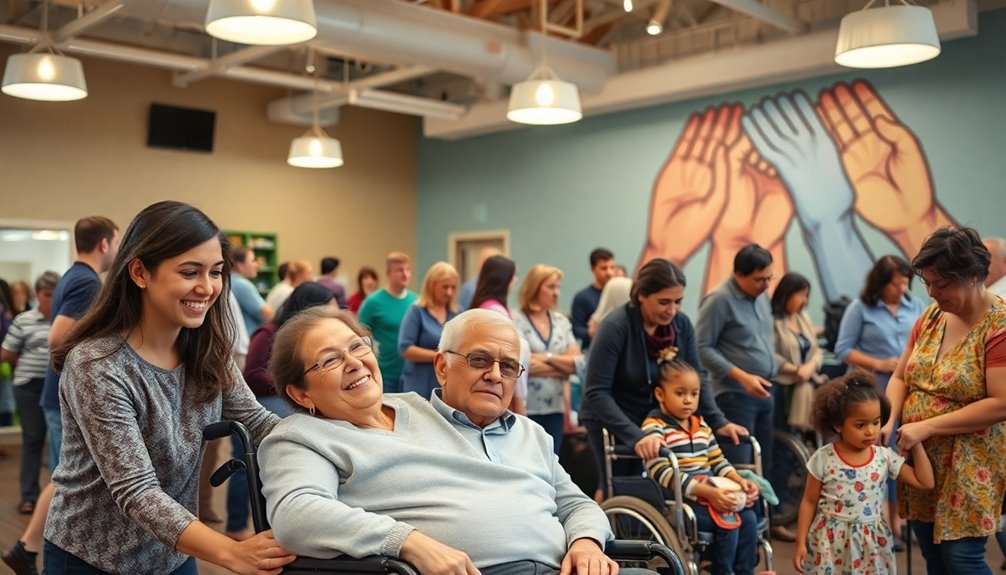Approximately 100 million adults in the U.S. serve as caregivers, which includes 53 million classified as family caregivers. This number has seen a dramatic increase from 43.5 million in 2015. Many caregivers dedicate around 26 hours a week to their responsibilities, balancing these roles with full-time or part-time jobs. The growing demand for caregiving support is impacting families and communities considerably. Discover more about the demographics and economic effects of caregiving.
Key Takeaways
- Approximately 100 million adults serve as caregivers in the U.S., marking a significant rise from previous years.
- 53 million of these caregivers are classified as family caregivers, providing essential support to loved ones.
- Over 25% of Americans aged 50 and older are involved in caregiving roles.
- The number of caregivers increased from 43.5 million in 2015 to about 100 million in 2023.
- Nearly two-thirds of family caregivers also manage full-time or part-time jobs alongside their caregiving responsibilities.
Overview of Caregiving in the US

In the U.S., around 100 million adults serve as caregivers, highlighting the critical role of family support in today's society. Of these, 53 million are family caregivers, looking after spouses, elderly parents, or special-needs children.
The demographics of caregivers show that over one in four Americans aged 50 and older are actively involved in caregiving responsibilities, with women leading the charge—32% of women aged 50+ are caregivers compared to 22% of men.
This rise from 43.5 million caregivers in 2015 indicates a growing dependence on family support. Caregivers contribute nearly $44 billion in direct costs to the U.S. economy, emphasizing not just their emotional commitment but also their significant financial impact.
Rise in Caregiving Statistics

You might be surprised to learn that the number of caregivers in the U.S. has skyrocketed to about 100 million in 2023, up from 43.5 million just eight years ago.
This surge not only highlights the growing demand for caregiving support but also reveals the significant economic impact these roles have on both families and the broader economy.
Understanding the demographics of caregivers, especially those in the sandwich generation, can shed light on this pressing issue.
Caregiver Population Growth
The caregiver population in the United States has skyrocketed to about 100 million adults in 2023, a dramatic increase from 43.5 million just eight years earlier.
This surge in caregiving reflects a growing need within families, with 53 million adults caring for spouses, elderly parents, or special-needs children.
The average caregiver now dedicates 26 hours per week, up from just 9 hours in 2020.
Most caregivers belong to the sandwich generation, aged 35-64, with millennials emerging as the largest group of full-time working caregivers.
These caregiver statistics highlight the evolving dynamics of the adult population and the increasing demand for support in caregiving roles.
It's clear that caregiving is becoming an integral part of many lives across the nation. Advance directives can also provide crucial guidance for caregivers in making medical decisions for loved ones who cannot communicate.
Economic Impact of Caregiving
Caregiving greatly impacts the U.S. economy, with a staggering $44 billion in direct costs associated with providing care.
Approximately 100 million adults act as caregivers, with 53 million managing the needs of spouses, elderly parents, or special-needs children. This rise in caregiving statistics highlights the growing economic impact on families.
As more caregivers balance work and unpaid care, many struggle to maintain their financial stability. The average hours spent caregiving jumped from 9 to 26 hours weekly, reflecting increased demands.
With 61% of U.S. households relying on dual incomes, caregivers often face tough choices, affecting their job performance and overall economic contributions.
The direct economic cost of caregiving can't be overlooked in discussions about the labor market and financial health.
Caregiving Demographics Breakdown
With the economic impact of caregiving clearly demonstrated, understanding the demographics behind this trend is essential. Currently, around 100 million adults in the U.S. serve as caregivers, with 53 million caring for spouses, elderly parents, or special-needs children.
- Over 1 in 4 Americans aged 50 and older are caregivers.
- 70% of caregivers identify as non-Hispanic White, while 13% are African-American.
- 30% of those in their 50s and early 60s provide care.
These statistics highlight that caregiving responsibilities often fall on adults in their 50s and early 60s, impacting their health and well-being.
As you navigate these demographics, it's vital to recognize the growing demand for support among caregivers in various age groups.
Demographics of Family Caregivers

When you look at the demographics of family caregivers, age and gender play vital roles.
You'll find that a significant number of caregivers are older adults, with many in their 60s or beyond.
Additionally, women often shoulder more of the caregiving responsibilities, spending more time on average than their male counterparts.
Caregiver Age Distribution
As the landscape of family caregiving evolves, understanding the age distribution of caregivers becomes essential.
You'll find that many caregivers are older, with the average age of caregivers being around 63 years. Here are some key insights into caregiver demographics:
- 63% of caregivers are aged 63 or older.
- Female caregivers make up between 53% to 68% of the population.
- 32% of women aged 50+ serve as caregivers, compared to 22% of men.
These statistics highlight how many family members step up to care for their loved ones, often taking on significant responsibilities later in life.
Understanding this age distribution helps us appreciate the dedication and challenges faced by these caregivers.
Gender Differences in Caregiving
Understanding the gender differences in caregiving is essential, especially since these disparities shape how care is provided.
In the U.S., a significant 32% of women aged 50 and older serve as caregivers, compared to just 22% of men in the same age group. Women caregivers typically spend more time providing care, averaging 21.9 hours per week, while men average only 17.4 hours.
These gender disparities in caregiving roles are clear; women are more likely to assist with challenging tasks like toileting and bathing. On the other hand, male caregivers often focus on financial management and arranging other care services.
Ultimately, the majority of caregivers for older individuals, about 63%, are female, highlighting the critical role they play in caregiving.
Economic Impact of Caregiving

The economic impact of caregiving in the U.S. is staggering, with nearly $44 billion directly affecting the economy. Approximately 53 million adults are juggling caregiving responsibilities, often limiting their ability to maintain full-time employment.
This situation creates significant financial pressure on U.S. households, especially since nearly two-thirds rely on dual incomes for financial stability.
- Caregiving often demands an average of 26 hours per week.
- Many caregivers live in households under twice the federal poverty level.
- The strain of balancing work and caregiving affects both personal and national economic contributions.
As you can see, the economic burden of caregiving extends beyond individual families, influencing the overall health of the economy.
Gender Differences in Caregiving Roles

While many people take on caregiving roles, a clear gender disparity emerges, with women disproportionately shouldering these responsibilities. About 32% of women aged 50 and older are caregivers, compared to only 22% of men in the same age group.
This highlights significant gender differences in caregiving, as women account for 53-68% of all caregivers in the U.S. Female caregivers typically spend an average of 21.9 hours per week providing care, exceeding the 17.4 hours spent by men.
Furthermore, women often handle physically demanding tasks like toileting and bathing, whereas men are more inclined to manage finances. The uneven burden on women can adversely affect their health and financial stability, making it essential to address these gender differences in caregiving support.
Types of Care Needs and Recipients

When you think about caregiving, it's important to recognize the diverse needs of care recipients. Many people require support due to age, health issues, or disabilities, and understanding these demographics can help you grasp the full picture.
You'll also see how gender plays a role in caregiving responsibilities, shaping who provides care and how it's delivered.
Care Recipient Demographics
Understanding care recipient demographics reveals the diverse needs caregivers address in the U.S. A significant portion of care recipients includes:
- 41% older adults, often facing health problems or disabilities.
- 29% special-needs children, requiring tailored support.
- 42% experiencing memory or cognitive issues, highlighting the necessity for specialized care.
These statistics underscore the important role caregivers play in managing various challenges. Not only do they assist seniors with everyday tasks, but they also provide essential support for children with intellectual or developmental disabilities. Additionally, caregivers must often navigate common health concerns that can arise among their care recipients, ensuring they meet individual needs effectively.
Common Care Needs
Caregivers meet a wide range of care needs that vary considerably among different recipients. Approximately 66% of caregivers assist seniors facing health problems or disabilities, making elder care a significant focus.
Additionally, 23% provide support to individuals with intellectual or developmental disabilities, reflecting diverse caregiving roles. Many caregivers address physical disabilities, as 59% of care recipients struggle with mobility issues.
There's also a considerable need for specialized skills, with 42% experiencing memory or cognitive challenges. Furthermore, mental health concerns affect 22% of those receiving care, emphasizing that emotional support is essential in caregiving.
Understanding these common care needs guarantees that caregivers can provide the appropriate support tailored to each recipient's situation.
Gender Disparities in Caregiving
While women aged 50 and older represent a significant portion of the caregiving population, the roles they take on often differ from those of their male counterparts.
Women are more likely to face gender disparities in caregiving, often managing more challenging tasks related to health concerns.
- 32% of women in this age group serve as caregivers, compared to 22% of men.
- Women typically assist with personal care activities like toileting and bathing.
- Men tend to focus on financial responsibilities and care coordination.
This division highlights the unique burdens female caregivers carry, often balancing emotional and physical demands.
Understanding these disparities can help address the specific needs of caregivers and improve support systems for all.
Youth and Young Adult Caregivers

Youth and young adult caregivers play an essential role in supporting family members and friends, often taking on significant responsibilities at a young age.
An estimated 1.6 million youth caregivers aged 15-18 and 2 million young adults aged 19-22 are balancing these duties while facing unique challenges.
Many of you may find that caregiving cuts into your educational opportunities, with youth caregivers spending about 42 fewer minutes on schoolwork than peers.
Alarmingly, 27% of youth caregivers aren't enrolled in school, compared to just 18% of non-caregivers.
The need for policy support is urgent to help you navigate these challenges, as caregiving during formative years can hinder long-term educational attainment and economic stability.
Employment and Financial Status of Caregivers

Balancing work and caregiving can be incredibly challenging, as nearly two-thirds of family caregivers in the U.S. juggle full-time or part-time jobs alongside their responsibilities.
This dual role often leads to financial strain, with 44% of caregivers living in households earning below twice the federal poverty level.
Consider these facts:
- 22% of caregivers split their time between full-time work and caregiving.
- The average caregiving hours per week jumped from 9 hours in 2020 to 26 hours in 2023.
- 27% of caregivers dedicate 30 hours or more each week to caregiving tasks.
These statistics highlight the demanding nature of caregiving, impacting both employment and financial stability for many caregivers.
Health and Well-being of Caregivers

As caregiving responsibilities mount, many individuals find their health and well-being greatly impacted. Only 1 in 4 caregivers report good physical health, showing the toll caregiving takes on your body.
Additionally, 41% experience low overall well-being, highlighting the emotional strain you might feel. The mental health effects are concerning, with 47% of caregivers reporting increased anxiety or depression in the past year.
This stress can lead to substance abuse issues, as caregivers are 26% more likely to face these challenges compared to non-caregivers.
Furthermore, sleep deprivation is rampant; 77% of you might find it profoundly affects your overall health and caregiving effectiveness. Prioritizing your health is essential to sustain your caregiving role, and seeking support resources for caregivers can make a significant difference in managing these challenges.
Future Trends in Caregiving

With the expectation that two-thirds of the U.S. public will take on caregiving roles in the future, the landscape of caregiving is evolving rapidly.
You're likely to see a shift in responsibilities as more adults, especially younger generations, become involved.
- Increased recognition of family caregiving needs
- A growing number of caregivers aged 18-24
- Rising caregiver population due to an aging demographic
This trend means that you may face new challenges and demands as a caregiver.
As the population ages, the role of caregivers will expand, requiring adaptability and support.
Prepare for a future where caregiving is a shared responsibility, impacting not just individuals but families and communities alike.
Frequently Asked Questions
How Many Caregivers Are in the United States?
You're likely aware that caregiving is a significant role for many adults today.
It's estimated that around 53 million people are actively providing care, with a notable increase from previous years. This growing number reflects the changing demographics of caregivers, including millennials and those in their 50s and early 60s.
With such a diverse group, it's crucial to recognize the various backgrounds and experiences that shape their caregiving journeys.
How Many People Are Unpaid Caregivers in the US?
You'll find that about 53 million adults in the U.S. serve as unpaid caregivers. This number has risen markedly in recent years, reflecting a growing trend toward relying on family members for support.
Whether it's helping elderly parents or caring for special-needs children, many people step into these essential roles.
It's clear that unpaid caregiving is an important part of American life, with nearly 100 million adults involved in some way.
How Many Family Caregivers Are in the US in 2024?
Imagine a world where nearly 66 million individuals step up to care for loved ones—that's the reality in 2024.
You're part of a growing community of family caregivers, with about 29% of adults in the U.S. embracing this crucial role.
This surge reflects the increasing need for support as our population ages.
As you navigate this journey, remember that you're not alone; millions share your experience and challenges.
How Much Is a Caregiver Paid in USA?
In the U.S., a caregiver's pay averages about $15 per hour, but this can vary based on location and experience.
If you're working through a home health agency, you might earn around $20 per hour.
Many family caregivers, however, often receive little to no compensation, focusing on support instead.
Depending on your situation, full-time caregivers typically earn between $25,000 and $35,000 annually, with some states offering financial assistance programs.
Conclusion
As you reflect on the millions of caregivers in the U.S., consider the dedication and love each one brings to their role. With the number of caregivers on the rise, what would happen if we all recognized their sacrifices and supported them more? These unsung heroes often juggle jobs, families, and their own health, yet their impact is immeasurable. By understanding their struggles and contributions, we can foster a more compassionate society for everyone involved.










